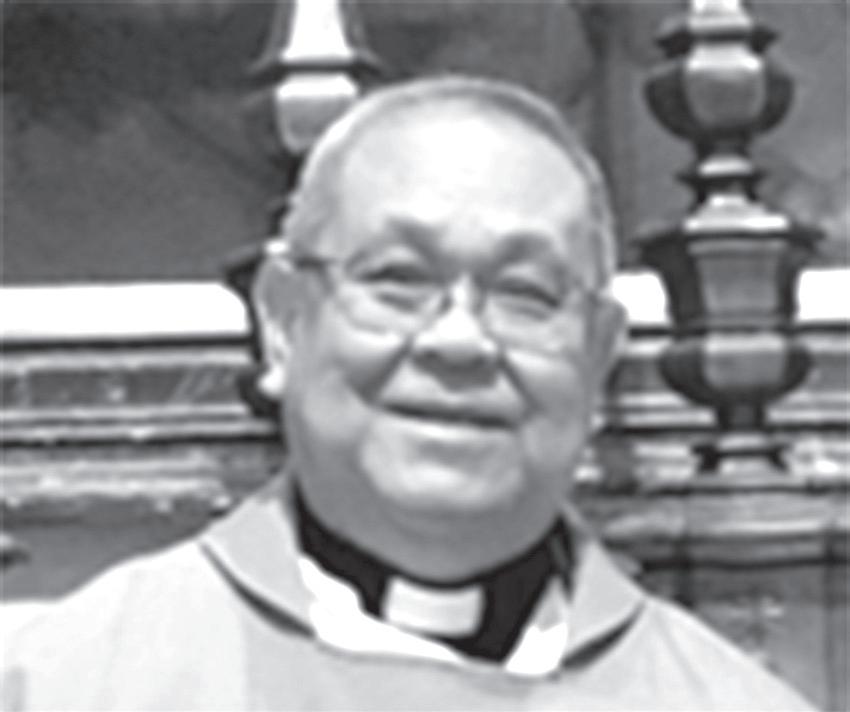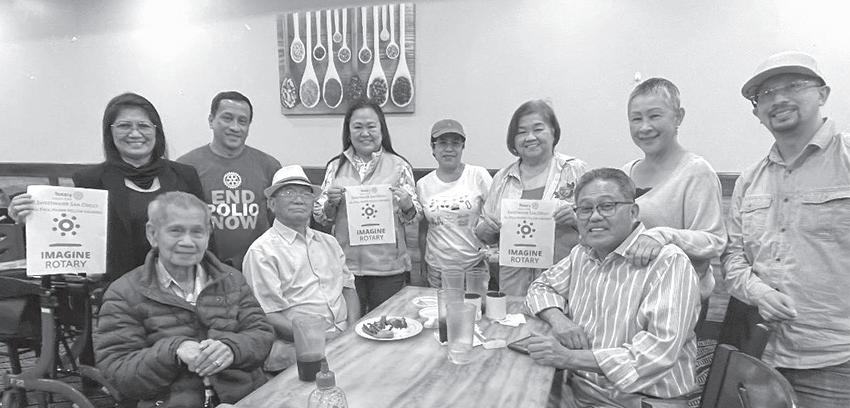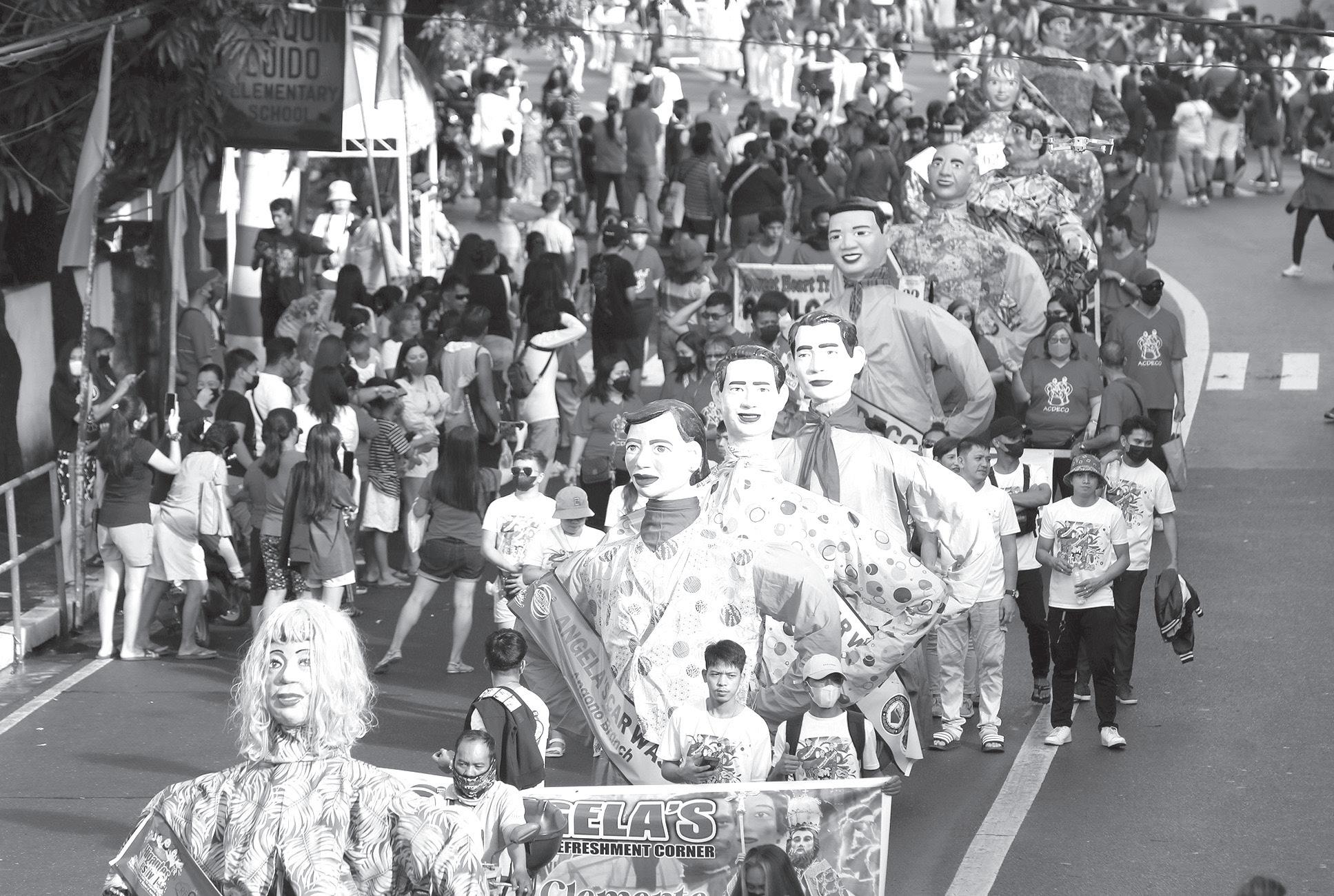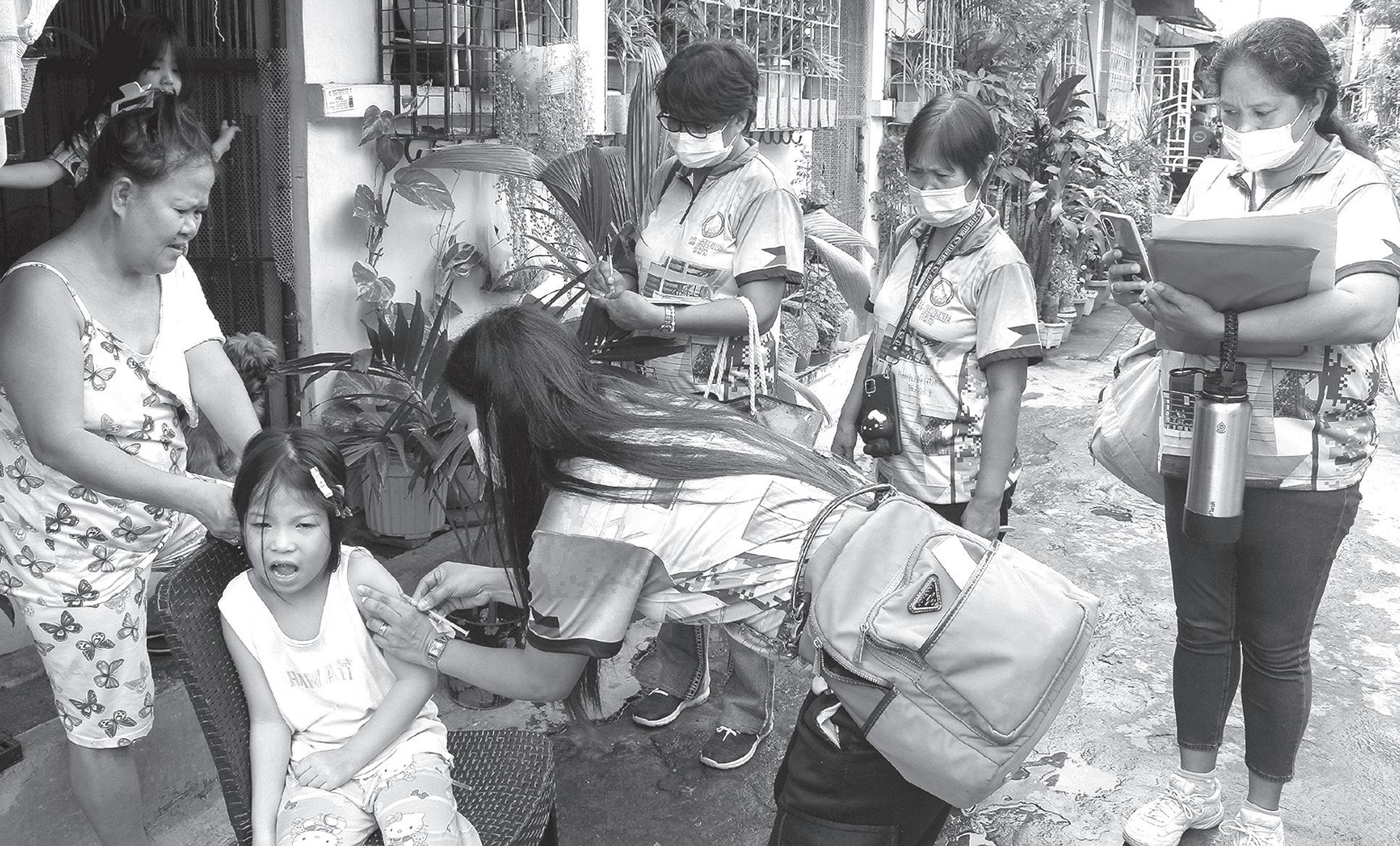MANILA -- President Ferdinand R. Marcos Jr. and US Vice President Kamala Harris on Monday hailed the "strong" and "enduring" ties between the Philippines and the United States amid global headwinds.

Harris, who paid a courtesy call to President Marcos in Malacañang, described the Philippines-United States relationship as a "long and enduring one."
"The relationship between the Philippines and the United States is a long and enduring one. It is one relationship that is strong for so many reasons. It is the longstanding relationship in terms of the peopleto-people ties, as you and I have discussed," Harris told the chief executive.

"The basis of our relationship is multifaceted. Our relationship is based on commitment to the economic prosperity of the region and our respective nations," she added.

Harris, the highest-ranking US official to visit Puerto Princesa City in Palawan province this week, also lauded the "thriving" Filipino community in the US in her meeting with President Marcos.
"In the United States, by last count, there are at least four million Filipino-Americans," said Harris.
Marcos, for his part, said with the "upheavals that we are seeing," the partnership between the Philippines and its longstanding ally "becomes even more important."
ByPeter Schurmann/emS
Harris
Harris



Harris is slated to hold talks aimed at reinforcing the longtime security and economic relationship between Manila and Washington.
Lifting women's economic status benefits society-- Harris
MANILA -- US Vice President Kamala Harris said on Monday lifting the economic status of women benefits society.
Harris met with Filipino women as part of her visit to the Philippines.


In a town hall meeting with women leaders, youth, and civil society organizations, Harris highlighted the importance of access to capital, equal access to financial literacy, and all opportunities critical to give women "a good idea, vision, and a plan" to thrive.



"You lift up the economic status of a woman, her family will be lifted, the community will be lifted, all society will benefit," she said.
The meeting came as the US announced its plan to invest in Filipino women entrepreneurs.
According to a White House fact sheet dated Nov. 21, the US International Development Finance Corporation will provide
"As we prepare for Thanksgiving and holiday gatherings, we need to continue being vigilant in preventing the rapid spread of winter viruses," said Dr. Erica Pan.
"As a pediatrician who specializes in infections, and a parent, it is concerning to see the rise in RSV and flu in babies, young children and our elderly population. It is crucial we are aware of prevention methods, but also, how to care for our loved ones at home, and what symptoms to be aware of for parents to seek care for their children."
CARING FOR YOUR CHILD
AT HOME:
There is no cure for respiratory viruses, but some medications can reduce disease severity in certain situations. For mild symptoms, Dr. Pan provides these tips to help ease discomfort:
Reduce congestion with nasal saline with gentle suctioning. Patients should sit or lie upright when possible. Cool-mist humidification also helps to clear the congestion and make people feel better.

Make sure your loved ones
get plenty of rest and drinks clear fluids such as water, broth or sports drinks to prevent dehydration. For infants, use electrolyte beverages such as Pedialyte. Healthy snacks and small meals are also recommended.
• If your child has a fever (100 degrees or higher), acetaminophen and ibuprofen can be given to children 6 months of age and older. Infants and children should not be given aspirin as this can cause a rare but serious illness called Reye's syndrome. Only use other medications or medications for infants less than 6 months old under the guidance of your health care provider.

• Follow dosing instructions listed on the back of the medication or from your health care provider.
• Stay home at least 24 hours after there is no longer a fever or signs of a fever (without the use of fever-reducing medicine).
WHEN TO SEEK CARE:
Most childhood respiratory illnesses are mild and resolve on their own without the need for emergency care or hospitalization. Understanding when to see a doctor or go to the hospital ensures that children receive the right care. Call ahead to get medical advice and see what you can do at home and when it is best to come in to be examined. Seek evaluation right away if you child has:
Symptoms of lung disease: fast breathing, flaring nostrils, head bobbing, grunting, or wheezing while breathing; belly breathing; pauses in breathing
Symptoms of dehydration
• Gray or blue color to tongue, lips or skin
Significantly decreased activity and alertness
Symptoms that worsen or do not improve after 7 days
• Fever in those under 3 months of age (12 weeks)
• Fever above 104°F repeatedly for a child of any age
• Poor sleep or fussiness, chest pain, ear tugging or ear drainage
IS YOUR CHILD AT A HIGHER RISK FOR SEVERE DISEASE?
Early evaluation and treatment by a health care professional can ensure the best possible outcomes for children who are at a higher
Amid acute staffing shortages made worse by Covid advocates for older adults say more needs to be done to protect the rights of residents in California’s long-term care facilities.
Do residents of long-term care facilities have rights? The question gained new urgency for elder care advocates in the wake of the Covid pandemic, which led to prolonged quarantines and isolation for residents amidst soaring infection and fatality rates.
Today, advocates worry residents’ basic rights — from proper health care to voting and even when and what to eat — are not being met amid acute staffing shortages.
“Every individual has rights that must be honored and protected,” says Blanca Castro, California’s Long-Term Care Ombudsman, a title Castro says originally comes from the Swedish word for “advocate.”
“Just because you go into a longterm care facility, you are still the same person you were before you entered. You still have a name; you have a family… you still matter,” said Castro.
She spoke during a Nov. 16 media briefing organized by Ethnic Media Services, in partnership with the California Department of Aging and the California Department of Health’s VaccinateAll58 campaign.

More than 400,000 people receive care in long-term care facilities in California annually. Their stays can be a short stint — after a hip replacement
or knee surgery — or long-term advanced care for memory-related illnesses or other ailments.
Castro’s office received more than 40,000 complaints last year, ranging from inappropriate discharges to medications not being given. Among the complaints, many had to do with residents not being allowed to see visitors during Covid lockdowns.


‘Dignity & independence’ for patients
“We are social animals,” said Castro. “We need voice, touch, contact. Facilities locked down during Covid, turning residents into prisoners… it did not have to be that way.” An estimated 10,000 people died from Covid in California nursing facilities in 2021. Social isolation contributed to many of those deaths, she stated.
New laws put in place since the start of the pandemic now require care facilities to have infection control plans — which dictate basic procedures like hand washing and mask wearing — that Castro says can help ameliorate the
isolation many residents experienced.
Castro, whose office is supported through taxpayer dollars, explained that while not an enforcement agency, one of the state’s more than 700 longterm care ombudsman — along with 35 related programs — will come to communicate with the resident and their family and can refer cases to relevant departments that are tasked with enforcement when necessary.
Dignity and independence are priorities for her office, Castro adds.
“The main question we ask is: what do you want? What does resolution look like to you?”
The Nursing Home Reform Act
Hagar Dickman, a staff attorney with the non-profit Justice in Aging, said The Nursing Home Reform Act lays out the full range of rights to which long-term care residents are entitled. Under the Act, facilities are required to provide the highest level of care they are functionally capable of.
“Person centered care guided by
"The situation is rapidly changing. We must evolve to be properly responsive to that situation, so that is why it is very important that we continue to progress, that we
continue to strengthen as we redefine those relationships," Marcos pointed out.
"Your visit is a very strong symbol that these relationships remain
strong, that these relationships remain important as indeed they do. The Filipino, I have said, many times, I do not see a future for the Philippines that does not include the
United States," the President told Harris.
arrived in the Philippines on Sunday, in what was the first visit in five years by a high-ranking
US official since former President Donald Trump visited the country for the 2017 Asia-Pacific Economic Cooperation (APEC) Summit.
was accompanied by her husband, Second Gentleman Doug Emhoff.
SACRAMENTO, CA -- As Respiratory Syncytial Virus (RSV), the flu and COVID-19 continue to impact Californians earlier than usual this year, state Epidemiologist Dr. Erica Pan urges everyone across the state to protect themselves and their families against many circulating viruses.
Since 1986 November 25, 2022 December 1, 2022 www.thefilipinopress.com • (619) 434-1720 San Diego’s No. 1 Source of News & Information for the Filipino Community • An Award-Winning Newspaper ENROLLING NOW FREE CLASSES ONLINE AND IN PERSON EDUCATION | P12 PAMPERED PINAY: LOVIN' LEFTOVERS SPECIAL RECIPE SHARED EMPOWERMENT | P2 WE hAVE jObS AVAILAbLE vISIt/APPLy At tHE StORE WEEkly SAlES | P14 See CDPH on 10 See PBBM on 10 Dr. Erica Pan A Bill of Rights for Long-Term Care Residents
PBBM, VP Harris: 'PH-US relations remain strong, enduring' See LONG TERM on 10 CDPH's Dr. Erica Pan Provides Guidance for Parents About Winter Viruses State Epidemiologist and Pediatrician Shares How to Care for Children at Home and What Symptoms Parents Should Look Out For
WARM WELCOME. President Ferdinand R. Marcos Jr. (left) shakes hand with US Vice President Kamala Harris during a courtesy call at Malacañan Palace on Monday (Nov. 21, 2022). Harris, who is on a three-day working visit to the Philippines, will also fly to Palawan on Tuesday. (MNS photo)
By Francine Maigue
My friends, I hope you enjoyed the best Thanksgiving yet. In a world and at a time when so many people near and far are experiencing great need, loss and uncertainty, I am humbled by and grateful for the ability to celebrate the holiday and share a Thanksgiving meal amongst loved ones. I pray that peace, comfort and resources reach each individual and family in need with great urgency and abundance, and I am committed to helping in any way I can.
It’s a blessing to be able to enjoy a lavish Thanksgiving feast. Having leftovers can feel like the gift that keeps on giving. Getting creative and hurriedly trying to empty a fridge full of leftovers can also feel quite daunting. Not to worry, though, my friends. This week, I’m sharing key ingredients that help create some of my favorite Thanksgiving leftover transformations. Kaya natin ‘to!
1. Roast Beef → Kaldereta
Leftover: Roast Beef
Simply add: Potatoes, onion, garlic, bell pepper, carrots, peas, tomato sauce
Directions: Cut veggies into bitesized pieces. Soften potatoes and lightly brown onion in a little oil. Add sliced roast beef, bell pepper, minced garlic and tomato sauce.
Once simmering, add peas. Season with bay leaves, salt, pepper, red pepper flakes and sugar to taste. Serve with rice or mashed potatoes.
2. Turkey → Calandracas

Leftover: Turkey


Simply add: Potatoes, onion, garlic, carrots, squash, cabbage, chicken broth, macaroni
Directions: Cut veggies into bite-sized pieces. Shred or cut turkey into bite-sized pieces. Soften potatoes and lightly brown onion in a little oil. Add chicken broth. Once boiling, add macaroni, carrots, squash and minced garlic. When macaroni is al dente, add turkey and cabbage. Season with bay leaves, salt and pepper to taste. Add milk to thicken as desired. Serve with pan de sal.
3. Ham → Ham and Cheese

Hot Pockets
Leftover: Ham
Simply add: Cheese, Honey Mustard, Puff Pastry
Directions: Preheat oven to 450 degrees. Cut thawed puff pastry into desired serving shape and size. Brush each center with honey mustard. Place a slice of ham and a slice of cheese in the center. Brush edges with beaten egg and cover with a second layer of puff pastry (like a sandwich). Crimp the edges of the pastry with a fork to seal. Brush the top of each hot pocket with remaining egg. Bake until
puffed and golden brown (appx. 20 minutes). Serve with scrambled eggs for breakfast or with a side of greens for lunch or dinner.
4. Stuffing → Stuffed Mushrooms
Leftover: Stuffing
Simply add: Mushrooms, Bacon, Garlic, Cheese
Directions: Cook bacon until crispy. Remove from pan, and add crumbled bacon to stuffing. Remove stems from mushrooms and mince.
Lightly sauté minced mushroom stems and minced garlic in bacon fat. Add cooked mushrooms and garlic to stuffing. Spoon stuffing mixture into mushroom caps. Top with cheese, and sprinkle with black pepper or red pepper flakes. Bake on a lightly greased sheet pan until mushrooms are cooked through. Serve as hors d’oeuvres or as a side dish.
Prayer to Saint Expedite
May the intercession of the glorious martyr , St Expedite, recommend us, O my God, to Thy goodness, in order that his protection may obtain for us what our own merits are powerless to do. Amen.
We supplicate Thee, Lord , to inspire by Thy grace all our thoughts and actions, that thou being their principle, we may, by the intercession of St. Expedite, be conducted with courage, fidelity and promptitude, at the time proper and favorable, and come to a good and happy end, through our Lord, Jesus Christ Amen
St Expedite, honored by the gratitude of those who have invoked thee at the last hour and for pressing cases, we pray thee to obtain from the all powerful goodness of God, by the intercession of Mary Immaculate, (today or such a day) the grace we solicit with all submission to the Divine Will Amen
2 • November 25, 2022 - December 1, 2022 Filipino Press www.thefilipinopress.com
Tasty and creative left over turkey recipes in this issue. Thanksgiving: Lovin’ Leftovers
GENERAL’S WARNING: Smoking Causes Lung Cancer, Heart Disease, Emphysema, and May Complicate Pregnancy. 4 8 CARTONS START AT Open 24/7 | Drive-Thru Service for your convenience! Full line of Seneca, Tracker & Black 33 with an assortment of loose tobacco and chews. SUPERIOR NATIVE MADE Micro-Manufactured Tobacco Products
SURGEON

www.thefilipinopress.com Filipino Press November 25, 2022 December 1, 2022 • 3












4 • November 25, 2022 - December 1, 2022 Filipino Press www.thefilipinopress.com
A FORCE TO BE RECKONED WITH: FILIPINO POPULATION IN U.S. NOW NEARLY 4.1 MILLION ACCORDING TO NEW CENSUS DATA
SAN DIEGO, CA -- Cheers!
United States Vice President Kamala Harris on Monday, November 21, 2022 arrived at Malacanang Palace back in our old homeland –the Philippines – for her courtesy call on President Ferdinand “Bongbong” Marcos Jr.
Before her scheduled meeting with Marcos, Harris, the first woman and first woman of color to become US vice president, met with her Philippine counterpart, Sara Duterte.
During their meeting, Harris told Marcos that any attack against Philippine forces in the South China Sea would invoke the US mutual defense promises.
The two leaders also shared light moments during the talk. Marcos said he is very delighted to welcome the American leader in the Philippines.
“And we have been looking forward to the visit for a while, and we’ve been preparing for it. The Vice President has been working hard to make sure that the visit goes well and smoothly. So but we are happy that you have arrived. It is unfortunate that it is such a quick visit,” Marcos noted.
“We would have hoped to have shown you more of the Philippines. Although, I suppose you actually are doing that because you are seeing some of the prettiest parts of the Philippines in Palwan,” he added.
Marcos, in jest remarked: “And I’m sure you’re just going to the resorts and the beaches.”
In response, Harris ststed: “That is not the life I’ve chosen these days.”
For her part, Harris said she is happy that she visited the Philippines during the holiday season. She noted that the Philippines celebrates the Christmas season for three months every year, which she described as “wonderful.”
“Well, it is good to be here with you on this season. And as you said the basis of our relationship is multifaceted. Our relationship is based on mutual commitment to the economic prosperity of the region and our respective nations,” Harris declared.
But what struck me most is the importance she placed on the Filipino-American community in the US – saying there is now four million of them across the land - who are immensely contributing to the melting pot that is known as the United States of America. She also mentioned that she has Filipino-Americans on her own staff who always bring “lumpia” and other Filipino delicasies in their social gatherings. Indeed, she spoke highly of our fellow “kababayans” here in our adopted new country.
And I do believe that begs for more information on why Filipinos (or Filipino-Americans, for that matter) are genuinely a force to reckon with
here in our “good, old U.S. of A.” these days...so, he goes.
Migration from the Philippines to the United States began in the late 19th century and has ebbed and flowed since then, in response to evolving government and business relationships between the two countries and changing U.S. immigration policy. In 2016, more than 1.9 million Filipinos lived in the United States, accounting for roughly 4 percent of the country’s then 44 million immigrants. Between 1980 and 2016, the Filipino population in the United States nearly quadruple, rising from 501,000 to 1.9 million.
The Philippines, which was then the second largest origin country for immigrants was overtaken by India and China during the early 2000s and since 2010 has ranked fourth, after Mexico, India, and China.
Looking back – after the U.S. annexation of the Philippines in 1899, large numbers of Filipinos migrated to the United States to study or to fill agricultural jobs, primarily in California and Hawaii. As U.S. nationals, Filipinos were not subject to the same restrictions imposed on other non-European groups. Arrivals slowed dramatically following the Great Depression and passage of the Tydings-McDuffie Act in 1934, which set the Philippines on a track to independence after ten years and imposed strict immigration quotas on the islands of just 50 immigrants per year. However, after World War II larger numbers began arriving primarily as “war brides” of U.S. servicemen and as recruits into the armed forces, though some also came to train as health-care workers.
Starting in the 1960s, the Filipino immigrant population grew rapidly, in part a result of the 1965 Immigration Act’s removal of national-origin quotas. But this growth was also influenced by longstanding government, military, economic, and educational ties between the two countries, as well as Philippine policy that encourages and facilitates labor migration for development purposes. The unique historical experience of having once been U.S. nationals sets Filipinos apart from other immigrant groups that have arrived in large numbers since 1965.

Incidentally, the United States is home to by far the largest number Filipinos abroad.
Fast forward, do you – my dear folks – know that the estimated number of Filipinos or Americans with Filipino ancestry, in the United States has now grown to approximately 4,089,570 – and still going strong - according to the U.S. Census Bureau’s latest American Community Survey (ACS) data for 2018?
Yes, indeed - released just last
year, the estimate represents a population increase of more than 52,000 from the 2017 data. The ten states with the largest populations of Filipinos and Filipino Americans are as follows: California: 1,653,167; Hawaii: 367,952; Texas: 204,192; Nevada: 168,200; Washington: 162,658; Florida: 158,254; Illinois: 156,121; New Jersey: 143,845; New York: 141,640; and Virginia with 117,666.
“The numbers bear out that we as Filipino Americans are an ascendant community in the United States – a community where full power and potential has yet to match our significant and growing presence in American society,” says National Federation of Filipino American Associations (NaFFAA) President and National Chairman Brendan Flores.
“We have among the highest educational attainment rates. We are a significant force in the educational, health care and service industries. We have over one hundred thousand proud military personnel and retired military veterans. It’s abundantly clear: our imprint on America is unmistakable, our contributions are undeniable and our potential is immeasurable,” Flores added.
“The ACS data tells a compelling story about our community’s growth and place in America, but I believe it only tells part of the story,” states Carissa Villacorta, NaFFAA’s executive director.
“I believe there are more of us than the ACS numbers actually show. And since there is power in number, it is more important than ever to make sure you and all your family members are counted in the 2020 decennial census,” Villacorta declares.
“By raising your hands and voices, you can bring more resources to your local communities, increase funding in your local schools and speed up improvements to local cities and counties. The Census can truly have the potential to improve the quality of life for all Filipinos and Filipino Americans, and we are committed to ensuring that we are counted fairly and accurately.”
Absolutely, our “kababayans” (fellow countrymen/women) have been part of American history for many centuries. The first Filipinos landed on the continent in 1587, several decades before the Pilgrims arrived. Before our Founding Fathers declared independence from the British, a group of Filipinos had already settled in Louisiana. More than a century before Alaska became a state; Filipinos had already made it here, engaging in fur trade with Alaska Natives.

Filipino-Americans have certainly made immensely significant contributions to our nation. In
the early 1920s, many Filipinos called the “Manongs,” left their native country and their family to work in the plantations of Hawaii and California and the fisheries of Washington and Alaska. During World War II - Filipinos both here and back in the Philippines, fought with and for the U.S. to help protect our freedom and secure peace in our world. In the late’60s and ‘70s, many Filipino professionals left their birthplace to help fill the workforce of our rapidly growing technology and health industry. As the families of the “Manongs,” veterans and professionals grew, their family members took on the critical jobs that helped in the development of our nation’s health and economy. Filipino-Americans worked in the health field, service industry, hospitality, technology, education, government, armed forces and construction, among many others.
The U.S. assuredly provided plenty of opportunities to FilipinoAmericans so that they could achieve the American dream.
Rear Admiral Connie Mariano is a Filipino-American who served as President Clinton’s physician. Chef Cristeta Comerford is also a Filipino-American who has been the White House Executive Chef since President George W. Bush. Thelma Buchholdt of Alaska was the first Filipino-American state legislator and Benjamin Cayetano of Hawaii was the first Filipino-American governor. Rapper Apl.de.ap of the Black Eyed Peas and actor Lou Diamond Phillips is FilipinoAmericans. The Los Angeles Rams’ MVP and Pro Bowl quarterback Roman Gabriel and NBA coach Erik Spoelstra of the Miami Heat are both Filipino-Americans. Those are just a few Filipino-American notables; and there are many more that can fill the pages of any local newspaper.
Despite the success of some Filipino-Americans, let us not lose sight, however, that America was not and is not always a “land of milk and honey” for many FilipinoAmericans. The “manongs” faced much discrimination and injustice. In the 1930s in California, they were not allowed to marry Caucasians. It was also not uncommon for them to see the sign, “No Filipinos Allowed,” on the windows and doors of some business establishments in parts of California. Those who worked in plantations and fisheries faced poor working conditions and did not receive decent pay. Although such blatant form of discrimination and injustice do not seem to exist today, prejudice and inequities are still problems faced by many Filipino-Americans. Many still express that they have been subjects of negative stereotypes, racism and social barriers in their schools and
T. Reyes Filipino Potpourri
workplaces.
And despite making up 1 percent of the American population, only one person of Filipino descent is currently a member of the U.S. Congress – Democrat Rep. Bobby Scott of Virginia. Prior to Scott, Congress saw at least one other voting member of Filipino descent in former Republican Rep. Steve Austria from Ohio, according to the Congressional Asian Pacific American Caucus (CAPAC). Former Republican Sen. John Ensign from Nevada also claimed Filipino heritage, though he is not documented by the U.S. Congress’ Office of the Historian as having AAPI ancestry.
By while the community hasn’t historically been elected to office or donated to campaigns, it is active in other ways, I must say. FilipinoAmericans primarily participate in politics by voting. In fact, according to research from AAPI Data, 59 percent of Filipinos were registered to vote and 50 percent of them voted in the 2016 election, ranking third among other Asian-American groups.
Apart from voting, FilipinoAmericans’ strength tends to be in labor-based activism dating back to the ‘60s, the decade when Filipino labor leaders joined forces with Mexican farm workers in the Delano Grape Strike to protest poor wages and working conditions.
As one professor who specializes in Asian-American politics at the University of California, Santa Barbara noted, “I think…this is a group that has been neglected, and this actually a group that has a lot of potential. They could do a lot more in terms of visibility in mainstream politics, but you need some role models, you need some cases of success.”
I say it’s a very exciting time next year. The interest in 2024’s politics is particularly high and in particular, communities of color – FilipinoAmericans included – are running for public office…many people are already predicting we’re going to see history being made.
So, keep pressing on…my “kababayans!”
In unity, we can all make it happen.
Lastly in our subject narrative, most Filipinos today in the United States who obtain lawful permanent residency (“LPR” status, also known
as getting a green card) do so through family reunification channels, either as immediate relatives of U.S. citizens or through other family-sponsored outlets. Many also get green cards through employment preferences.
Meanwhile, statistics show that Filipinos are more likely than other immigrants to have strong English skills, and have much higher college education rates than the overall foreign-and U.S.-born populations. They are also more likely to be naturalized U.S. citizens than other immigrant groups, have higher incomes (in 2016, households headed by a Filipino immigrant had a medium income of $87,000 compared to $54,000 and $58,000 for all immigrant and U.S.-born households, respectively) and lower poverty rates (further, in 2016, just 5 percent of Filipino families were living in poverty, a much lower rate than the 9 percent recorded for the U.S. born and 15 percent for immigrant families overall), and are less likely to be uninsured (also in 2016, 7 percent of Filipinos were uninsured, the same as for the native born, compared to 20 percent of all foreign born).
Truly, as an immigrant group we have really come a long way in America!
Therefore, I say celebrating Filipino-American History Month yearly – as recently just last month of October is very important. It is a remembrance and commemoration long overdue to a group of people referred to by the late Dr. Fred Cordova as the “Forgotten Asian-Americans” and who have significantly contributed immensely to our nation for centuries. Moreover, history validates our existence as a community and since annals is part of the culture that defines us, awareness of it is the first step to cultural tolerance and appreciation, which in turn is a precursor to healing racism and eliminating discrimination.
No doubt about it, Filipinos immensely helped shape the America of today!
So, my dear “kababayans” – let us just pause for a moment and ponder about it all – It’s not the good, old U.S. of A., if there’s no Philippines (or Filipino-Americans, for that matter) in its narrative…Amen!
Mabuhay!!
Discerning the synodality path for Filipinos, Part 6
The distinction between revolutions is an important one with regards to how the state behaves. In the words of Karl Marx, the state is a product and a manifestation of the irreconcilable class antagonisms which it is powerless to dispel. It rises where, when, and insofar as class antagonism cannot objectively be reconciled. Such has been the case in the Philippines.
Revolutions led by the military and the elites like the EDSA Revolution, or the rebellions against Spain and the United States, have never proven to be an organ for reconciliation of classes. On the contrary, they become part of the oppressive rule. Democracy, as espoused by the ruling class, used the organs of the state (military, police, and other instrumentalities of government) to maintain order for their benefit under the framework of neoliberalism.
Neoliberalism as an accepted truism, proposes that human wellbeing can best be advanced by espousing democratic visions of entrepreneurial freedoms as supported by a framework of
individual liberty, unencumbered markets, and free trade. The lingering colonial mentality made it easy for locals to accept such universal concepts and has influenced the way they think.
The prevailing victors of revolutions maintain such narratives through control of mass media and through government institutions (i.e., the Department of Education perpetuating the narrative). Those who refuse to recognize such hegemonic concepts are looked at with disdain and must be communists or socialists.
Neoliberalism in the guise of democracy, appeals to the upper class because it effectively prevents an equitable distribution of wealth. The desire of the ruling class to retain their privileges in society finds themselves with two options: redistribute their wealth to the poor or shift toward authoritarianism.
In the Philippine context, it is easy to discern which option is more palatable to the upper class. As a matter of fact, oligarchy produced more billionaires post EDSA. Such as the primordial driver
of class struggles. It is with this background that the Philippine Catholic Church should recapture the essence of being called the Church of the Poor. This includes reaching out to those who left the Church to pursue their struggle for social justice and for an equitable society. It is in this context to view Pope Francis’ comment that “The future of the Church is in Asia.”
The Communist Party of the Philippines through its military arm perpetuates violence because they are aggrieved and excluded from power, much like the Huks before them. They challenge the ruling class and its military arm, to impose their own model of governance following communism as an ideology. Clearly, neoliberalism and communism will always clash infinitum. Neither extreme ideology is beneficial to the Catholic Church, if it truly believes its own Christian democratic ideology.
Hence, the need for the Catholic Church to step up. To be an effective player, however, the Philippine clergy needs to reinvent itself. First, it needs to follow the lead of Pope Francis because it shows that the Vatican’s journey from anticommunism to anti-capitalism has evolved. The overture he made to China should be viewed in the spirit of synodality.
The pope’s strong condemnation of income inequality and free markets signals that modern
capitalism is the new enemy as he debunked the “virtues” of trickledown economics. Certainly, wealth has not trickled down to the poor in the Philippines. What this means is that there is a need to redefine “sin” in the context of economic inequality.
Sin as an ethical concept deviates from the normal definition of sin as an illness, an infraction against the conventional edicts of the church that merits punishment in the afterlife. Thomas Aquinas referred to sin as the consequence of the final cause (human inclination to sin). As an ethical concept akin to the Latin American thinkers like Father Gustavo Gutierrez, sin is no longer just about self, but humanity in the process of liberation.
Capitalism is an ideology and therefore, not capable of sinning. Yet, its effect (vis-a-vis, poverty, income inequality) is a moral failure in need of accountability. The ruling class hides behind capitalism to avoid a semblance of culpability (technical sin), and ultimately, punishment. The Philippine clergy for all intents and purposes, fails to look at the ruling class’s culpability by looking the other way. Plainly, Aquinas never meant for technical sin to go unpunished because sin is the cause of injustice.
In a wider sense, engaging in capitalism does not mean its objective is to harm people. But, when viewed in the context of corporate greed
as in profiteering even during the pandemic, capitalism is what brings misery, poverty, pollution, worsening climate, illegal drugs, among others, that result in many deaths. Excessive profit making is brilliant, but the resultant deaths because of it are sins against Natural Law and God, who created them.
Therefore, Pope Francis is morally correct in making capitalism enemy number one. But the bigger question is, how do you put this into practice. For starters, Philippine prelates need to balance the clamor of the NPA in the context of social justice. Liberation theology is not just the negation of sin, but positively, should result back to what Jesus wants us to do – to love and fellowship with our neighbor.
The current form of government has miserably failed to address land reform and the equitable distribution of wealth. By extension, the alliance between successful capitalists with the political power of the government must be put in check. Apolinario Mabini dreamt of a parliamentary form of government. Perhaps, that can be a starting point when looking at the merits of federalism.
Political dynasty was a favorite bogeyman for opposing federalism for fear of perpetuating it more. Historically, however, political dynasty is the product of the current presidential form of democracy working in tandem with capitalism. They are the ruling elites who fail to
craft the implementing rules for the anti-political dynasty provisions of the Philippine Constitution because doing so would be inimical to their economic interests and political survival.
Hacienda Luisita is exhibit A where the president had the Chief Justice removed because his actions devalued the Aquino estate. Even more galling is the fact that illegal pork barrel in a different name (Distribution Acceleration Program or DAP) was used to convict the Chief Justice. Aquino was indicted for DAP but was given a pass due to a technicality that he was an impeachable official. This proves that the current system can be manipulated by the president who controls the other branches of government.
When Aquino died, Cardinal Jose Advincula, Archbishop of Manila led influential Church leaders in extolling the former president. CBCP president Bishop Virgilio David alluded to the Aquinos’ efforts to restore democracy in the Philippines.
Retired Bishop Arturo Bastes of Sorsogon was brutally honest, “he was a hard-working president who greatly improved the economy of the country.” Democracy, economy were their themes. The late dictator’s daughter, Sen. Imee Marcos, was more forthright that despite the younger Aquino’s misgivings, he had a “kind and simple soul.” To be continued…
www.thefilipinopress.com Filipino Press November 25, 2022 December 1, 2022 • 5
Jesse















6 • November 25, 2022 - December 1, 2022 Filipino Press www.thefilipinopress.com Professional Business Directory PLACE YOUR AD TODAY! CALL: 619.434-1720 • E-MAIL: filpressads@aol.com • www.thefilipinopress.com WASH HANDS OFTEN STAY SAFE EVERYONE
























www.thefilipinopress.com Filipino Press November 25, 2022 December 1, 2022 • 7 Help Wanted / For Rent / For Sale
Counting our days
I found this article written by Professor Claude Mariottini entitled “Counting our days”, thoughtprovoking and very enlightening. Hence, I decided to share it with you, my readers.
“Teach us to count our days that we may gain a wise heart” (Psalm 90:12).
There are certain occasions of the year, especially birthdays, that compel us to count our days and realize how fast time passes by, which is in fact, the passing away of our lives. It is at this time of reflection, when we celebrate our birthday, a new year of life, that we realize another year is gone. Each new year of life compels us to number our days and as we do, we realize that the passing away of our days brings us closer to the day we will meet our Maker.
“For everything there is a season, and a time for every matter under heaven: a time to be born, and a time to die” (Ecclesiastes 3:1). We cannot change these two fixed days in our lives, but we surely can influence what happens between the time of birth and the time of death.
This is the reason the psalmist said that we must learn to number our days in such a way that we may gain a wiser heart. If the time between life and death is the time of our education for the future, then we must learn not to waste our precious little time and throw away the opportunities the school of life offers to us. Life is a school, the place where we train daily to face the challenges of the future.
As we count our days, we cannot be indifferent and unaffected by the fact that twelve months more of life have passed away. During the passing of those twelve months, most of us have experienced joys and sorrows that will be part of our memories until the end.
Life is ephemeral. Most of us live for seventy years or so. With good health, some of us will live to eighty or even more (Psalm 90:10). To us who are limited by time, seventy or eighty years appear to be
Aurora S. Cudal-Rivera My

Personal Testimony
a vast stretch of time, but to God, a thousand years is scarcely any time at all. For a thousand years in God’s sight are but as yesterday. Time has no relation to God; it does not affect him: “ For a thousand years in your sight are like yesterday when it is past, or like a watch in the night” (Psalm 90:4). The psalmist said that to God a thousand years is like one day, like a watch of the night, a mere four hours. A thousand years or a day is all the same to God.
In God’s time our lives last from morning into evening, the psalmist prayed: “Satisfy us in the morning with your steadfast love, so that we may rejoice and be glad as long as we live” (Psalm 90:14). By learning to rightly count the days of his life, the psalmist was asking God to enable him to take to heart the lessons which the brevity of life should teach him.
Since the school of life teaches us that life is ephemeral, we must then learn how to seek that which is eternal. We do not know whether our days will be few or many. So brief is human life that not everyone will enjoy the blessings of old age, because death can come suddenly and our lives be removed in the middle of our blossoming years, before our flower withers.
Our education in the school of life prepares us to recognize that life is a precious gift of God. So, as you celebrate your birthday today, you must remember that the sun is setting and the evening of your life is fast approaching.
Spiritual Life Happy Thanksgiving!
For those who have faith in their Creator, the setting of the sun will not lead them into a dark and fearful night, but into a glorious morning, into another day that will have no end. But in order for them to rightly number their days that they might become wiser, they must remember the one who created them: “Remember your creator while you are young, before the evil days come, and the years approach when you will say, ‘They no longer give me pleasure’” (Ecclesiastes 12:1).
In order to gain a wise heart, we need God’s teaching, for “the fear of the Lord is the beginning of wisdom” (Proverbs 9:10). God alone can teach us the real meaning of life and the lasting values that can lead us to abundant living.
When we number our days, we realize the brevity of life, that we must give our attention to matters that last, to eternal things. Life is short and since life is short, it should be wisely spent. We do not have enough time to dissipate our precious life in things that do not last nor are we sure that we have enough days in our lives that we may postpone the times of our decision. When we gain wisdom, we discover what are the most important things in life. The Bible teaches us that the wisdom that leads to abundant living comes from God.
Happy Birthday.
 Claude Mariottini Professor of Old Testament Northern Baptist Seminary
Claude Mariottini Professor of Old Testament Northern Baptist Seminary

Today is the first Sunday of Advent, the beginning of the new liturgical year of the Church. This season helps to prepare for the coming of Jesus. Our gospel this Sunday taken from the gospel of Matthew narrates to us an extended conversation between Jesus and his disciples about “the coming of the Son of Man. This prophecy has dual levels of meaning. First, it indicates judgment. The catastrophic destruction of Jerusalem in 70 A.D. by the Romans, in which the Temple of the Old Covenant was destroyed, was the first fulfillment of warning of Jesus. Luke wrote of this prophetic warning to remind his community of judgment day, when God would judge them according to their acceptance or rejection of the Messiah. Second, it also refers to his promised return to this earth, when he will bring Evil to a definitive end, and likewise bring judgment on all who willingly gave themselves over to it. It speaks of his glorious reign among his faithful, bringing to fulfillment the prayer that he taught us” Your Kingdom come, Your will be done on earth, as it is in heaven.”
For both judgment day and his glorious reign on earth, the essence of the warning of Jesus is the call to “stay awake.” On several occasions, he makes great emphasis on not knowing the day nor the hour of his coming in order to drive home the
point which we might otherwise miss. His point being that the exact “hour” is unimportant. What is crucial is that we not postpone our repentance and that we be spiritually and morally ready for him when he does come. For he will come, he tells us, like the thief in the night, and like the flood in time of Noah. And to underscore the urgency of this call, Jesus uses this imagery: the thief in the night and the flood in the time of Noah. They allude to the complacent attitude of the people then, which is similar to the mindset now prevalent during our time. The people carried on with the ordinary events of human life without a care in the world and with no fear of the Lord; not realizing the trouble that lay ahead for them.
This season allows us to remember and be aware that though we sit in the darkness, overshadowed by death, we have Jesus as our Lord
who is the light who has come into our midst. He is the true light, the life of the world. For this reason we have the advent wreath with four candles that remind us of Jesus as the light we will always give us hope in the midst of darkness, pain and sufferings in the world. His light continues to shine in his church, the new Jerusalem promised by Isaiah in the first reading. In the Church, all nations stream to the God of Jacob, to worship and seek his wisdom in the House of David. From the church goes forth his word of instruction, the light of the Lord, that all might walk in his paths towards that eternal day when night will be no more.
By our baptism, we have been made children of the light and day. It is high time that we start living as children of the light by throwing off the fruitless works of darkness, the desires of the flesh, and by walking in the light of his grace. Hence, as we usher in Advent this Sunday knowing that the hour is late, let us strive to begin anew in the Eucharist. Let us join together in singing joyful songs to the Lord. Let us give thanks to his Name, keeping watch for his coming, knowing that our salvation is nearer now than we had first believed. Let us do this as a community of disciples, looking forward to His indwelling in our lives.

Where I live, summer has vanished and autumn is in full swing. The nights are longer, the days are colder, and the trees have shed their leaves. The dramatic beauty of the change of seasons is a tangible reminder of God’s creativity. I remember how much he cares for me as I walk in the woods noticing how God cares for the birds overhead with their migration patterns. It can be challenging to remember God’s faithfulness in the midst of a world that feels unsettled and chaotic, yet God’s unchanging nature in the midst of changing seasons gives me so much hope. What a gift it is to rest on the promise of God’s perfect timing as the sun rises and sets and as seasons change! One way to respond to God’s gifts, trustworthiness, and provisions is through prayer. Our thanksgiving is an essential part of prayer. E.M. Bounds, an author and preacher from the late 1800s, wrote this about prayers and thanksgiving: Thanksgiving is just what the word itself signifies—the giving of thanks to God. It is giving something to God in words which we feel at the heart for blessings received… Wherever there is true prayer, there thanksgiving and gratitude stand hard by, ready to respond to the answer when it comes. (E.M. Bounds on Prayer, pp.96, 98)
It’s easy to pray thankful prayers for big specific answers to requests like a new job, a restored relationship, or healing from sickness. But we often forget to thank God for the gifts that we
From Whom All Blessings Flow
easily overlook. Have you ever thanked God for the beauty of trees? Have you ever stopped to praise God for the ability to smell or taste something delicious? Have you ever been led to pray for thanksgiving after a warm embrace from a loved one?
The apostle Paul tells the church in 1 Thessalonians 5:16-18, “Rejoice always, pray continually,Prayers of Thanksgiving_blog min give thanks in all circumstances; for this is God’s will for you in Christ Jesus.” How do we establish the rhythm of giving thanks in all circumstances? One suggestion is to start a daily habit of writing down five things you are thankful for. Keep this “Top Five” list handy so you can make a different list of things the next day. If this seems like a challenging task, please read Psalm 147 for some inspiration.
After a week take a look at your list, and reflect on God’s good gifts. How did he surprise you? Was there anything on your list that was repeated?
Thanksgiving is a perfect time to start a new habit of creating a “Top Five” list of things to thank
God for. You could read Psalm 147 out loud and create a list with your friends and family as you sit down for the holiday meal. Have each person say one or two things they are thankful for, then write them down on a piece of paper, and hang it up somewhere everyone will see it. During and after the meal invite everyone to add to the list—as the day goes on, you may need to add more pages. At the end of the day, take a look at the list you created and thank God for his very good gifts.
Prayers of thanksgiving are central to our prayer life. We give thanks in prayer because God the Father always provides for us, Jesus the Son offers us salvation, and the Holy Spirit empowers us to grow in our faith. And we know the grace of God only because of his goodness and faithfulness to us. May you give thanks to God for the many good things he has done!
Thank you for your dedication to praying for others. I invite you to share your “Top Five” with the Prayer Team here so we can continue to celebrate the very good things God is doing.
8 • November 25, 2022 - December 1, 2022 Filipino Press www.thefilipinopress.com Hello Dear Readers, Do you have stories, pictures, achievements, events or business leads to share? Feel free to email us at filpressads@aol.com We love to hear from you! Let our Fil-Am voices be heard, our achievements inspire our community, our pride & joy spread everywhere. Visit us at www.thefilipinopress.com Want to sell your products? PLACE YOUR AD TODAY! E-MAIL: filpressads@aol.com CALL: 619.434.1720 • FAX: 619.399.5311
Danny Hernaez
Fr. Agustin T. Opalalic
Greetings in the Lord!
Rotary club of Sweetwater San Diego District 5340 gets a visit from its sister Rotary Club of San Rafael District 3770
By Marissa de Luna SAN DIEGO, CA Past President
The micro lending project is one of Rotary International’s areas of focus, which is about loans to low income entrepreneurs who would otherwise be declined by big banks.
Four years ago, Rotarian Romeo Villanueva requested the club to start a Micro Lending project in the Philippines. Initially, he asked the club for funding and he offered to match the funds if the club would donate $2,000.00. The $4,000.00 immediately grew to $6,300.00 by way of donations from other members.


A Memorandum of Agreement was entered into between the club and Sacred Heart Development Credit

Cooperative (SHDCC) wherein the club would deposit Php315,000.00 ($6,300.00 X Php50.00 = Php315,000.00) in a special account with SHDCC. The latter would then implement the Micro Lending by: Qualifying the Micro, Small and Medium Entrepreneurs (MSME); Enrollment of the MSME into the cooperative; Providing the necessary loans backed by the club’s deposit to the MSME; Collecting payments from the MSME; Educating the MSME on the proper financial management
of their loans; Allowing the Sister Rotary Clubs to recruit from among the MSME possible members of the Rotary Community Corps Group.
To date, the club, through the collaborated efforts of SHDCC, has given out loans to over 100 MSME with a 100% rate of Repayment. The funds deposited have also generated interest income that have helped fund local projects of the club’s sister clubs, the Rotary Club of Meycauayan East and the Rotary Club of San Rafael, Bulacan.


risk of severe disease. Children who are at higher risk of severe disease include:
• Younger children, particularly 6 months old or younger
• Premature or low-birth weight infants

• Children with chronic medical conditions, including chronic lung diseases, heart
disease, disorders weakening the immune system, or neuromuscular disorders
TESTING FOR RSV:
Testing for RSV is not always necessary. Unlike COVID-19, testing for RSV generally does not change the way doctors manage individual patients with this illness and treatment is based on the symptoms a person is experiencing.
Accordingly, individuals should seek care based on concerns for the symptoms listed above and not solely to obtain an RSV test result.
Further, schools and childcare settings should not require a negative RSV test to return to these settings; in most situations, return should also be based on symptoms and generally children with respiratory symptoms should not return to childcare or school until symptoms are resolved or at least mild and improving. This includes waiting until 24 hours have passed since resolution of fever without the use of feverreducing medications. www.cdph.ca.gov
www.thefilipinopress.com Filipino Press November 25, 2022 December 1, 2022 • 9
The Filipino Press is published every Saturday. We welcome news, features, editorials, opinions and photos. Please e-mail them to: editor@ filipinopress.com. Photos must be accompanied by self-addressed, postage-paid envelope to be returned. We reserve the right to edit materials. Views and opinions by our writers, contributors does not necessarily reflect those of the publisher, management and staff of the Filipino Press. © 2011 Filipino Press Mailing Address: 600 E. 8th St. Ste. 3, NationaI City, CA 91950 • E-mail: filpress@aol.com Office: 600 E. 8th St. Ste. 3, National City, CA 91950 • Telephone: (619) 434-1720 • Fax: (619) 399-5311 Website: www.thefilipinopress.com • E-mail: filpressads@aol.com for ads • E-mail: filpress@aol.com for editorial Founding Editor and Publisher ERNIE FLORES JR. Editor-In-Chief SUSAN DELOS SANTOS Marketing and Sales info@thefilipinopress.com Graphics and Design A2 STUDIO G RA ph ICS F ILI p INO GRA ph ICS Contributing writers JOE GAR bAN zOS A DA m bE h AR ALICIA De LEON TORRES F R . AGUSTIN T. OpALALIC Cartoonist JESSE T REy ES Community Outreach ROSE SAN pEDRO LORNA D ELOS SANTOS Ch RISTINA RUTTER Columnists AURORA S. CUDAL DANN y h ERNAE z FRANCINE m AIGUE GREG b m ACA b ENTA JESSE T. REy ES AL v ILLA m ORA Photographer zEN y p Ly Circulation RUDy Av ENIDO “There is a mistaken notion among some that to own a paper is to have a license to clobber one’s enemies and attack people we don’t like.
information tool to reach a large number of
at a given time.
give
means
— Ernie Flores Jr.
Continued
page 1
A newspaper is an
people
A newspaper should inform, educate, entertain and provide viewpoints that could
us the
to make intelligent decisions for ourselves and others.”
, founding editor and publisher CDPH
from
Erwin Veneracion, RC of San Rafael detoured from his working vacation to visit RC Sweetwater. Veneracion is the branch manager of the Sacred Heart Development Credit Cooperative who handles the successful micro lending project going on its 4th year.
Stay in PH, we’ll support you: Marcos tells Filipino scientists
MANILA -- President Ferdinand R. Marcos Jr. on Wednesday called on Filipino scientists to stay in the country and share their expertise with the younger generation as he vowed to support their research and development (R&D) initiatives.
“I urge you to stay in the country as you pursue your career. We will continue to support you and continue to look to you to be active partners of the government. Let us dedicate our knowledge and skills, and work harmoniously so as to uplift the lives of our countrymen,” Marcos said in a speech during the 2022 National Science and Technology Week (NSTW) opening ceremony at the World Trade Center in Pasay City.
Marcos underscored the important role of Filipino scientists, researchers, inventors, and innovators in generating new knowledge and devising better strategies to safeguard and advance the well-being of Filipinos.
He, however, also recognized that many research ideas, particularly in the food and agriculture industry, are not immediately integrated into government programs.
“What [Department of Science and Technology Secretary] Dr. [Renato] Solidum [Jr.] and I discovered is that there are many research institutions that are doing really remarkably food research however problem that we are finding is that research is not directed. Everyone has their own program, has their own projects. It’s not their fault. They’re studying what they are interested in,” he said.
Marcos said it was the government’s job to “give direction” so that R&D outcomes are immediately useful to farmers; businessmen; micro, small and medium-sized enterprises (MSMEs) and citizens.
“I’ve spoken to some of the researchers and some of those administering research institutes around the country not only agriculture but all kinds of other R&D, and they’re willing to take direction from us, from the private sector as to what are the necessary technologies for the Philippines in terms of improving well again climate change mitigation adaptation and our foods supply, our economic transformation all of these things,” he said.
He said his administration will “wholeheartedly” support their R&D solution to the country’s problems, especially in agriculture and trade.
“The administration assures you our firm commitment to championing science and technology research, developing data-driven and sciencebased policies, and implementing evidence-based responses supporting your community,” he said.
More scholarships, stronger STEM program
Marcos urged the DOST and their partner institutions to provide more scholarships to Filipino students to develop a bigger pool of scientists, researchers and innovators in the country.
“Through this, we will institute a scholarship program specifically for STEM students and this will not be limited to those who have shown their capabilities, their ability, and how they deserve these scholarships here in the Philippines but to any institution that they are accepted to
abroad,” he said.
He also called for improvements in the country’s Science, Technology, Engineering, and Math (STEM) program, citing the need to become more globally competitive.
“Unfortunately in the Philippines when we are graded alongside our neighbors in Asia, in ASEAN [Association of Southeast Asian Nations], do not do very well when it comes to the STEM subjects and that is what we need to encourage.
The material I can see is available. It is just a question of us incorporating it into our curricula, it is just up to us to give it an emphasis because in every aspect the STEM subjects have become terribly, terribly important,” he added.
Marcos said the government must provide opportunities for scientists to learn new skills because science and technology will determine the country’s success in the coming years. “Whereas before we train people to be carpenters and plumbers and electricians and construction workers. Now the training is in computer science, it is encoding, it is block chain technology, it is computer engineering,” he said.
Marcos also tipped his hat off to his father, the late President Ferdinand E. Marcos Sr., for institutionalizing NSTW through Proclamation No. 2214.
“Through the decades, this celebration has continued to create a platform for professionals, for administrators, for policymakers, and for students to converge and collaborate in order to harness the power of science and technology — solving many of society’s problems, finding opportunities for growth and for development,” he said.
Enhancing quality of life
Meanwhile, Marcos acknowledged the efforts of the DOST and its attached agencies for continuously implementing programs that create solutions to address the country’s pressing problems such as food security, job creation, health education and climate change adaptation, among others.
“Every time we speak of any subject, we can talk about agriculture, we can talk about public works, we can talk about tourism, every subject, sumisilip yung subject ng climate change (the subject of climate change peeks through), it affects everything and everyone and so once again we look to science, we look new technologies, we look to engineers to find us solutions to mitigate, to adapt our very vulnerable country to the effects of climate change,” he said.
Among these valuable innovations, he said, are the DOST’s GeoRisk PH, the country’s platform for data gathering, sharing, and analyzing hazard and risk information, and the CRADLE and SETUP programs, which are designed to help companies as well as MSMEs improve their products, processes and service to boost their productivity and competitiveness.
“Your efforts do not only generate development opportunities for young scientists, they contribute to our shared goal of enhancing the quality of Filipino life,” he added.
He lauded the DOST for organizing the 2022 NSTW exhibits and activities that aim to educate,
encourage, and enhance the skills of scientists, inventors, and advocates.
“That is another very important part of the mission that you are having to fulfill is to get the information disseminated so that people know what might be applicable or useful in their own community situations. So I hope this year’s celebration will be a beacon of hope for all Filipinos to bounce back better by building upon science, technology, and innovation,” he said.
Before his speech, Marcos also visited the techno-exhibits which featured prototypes of e-tricycle and e-jeepney.
This year’s NSTW focuses on research and development (R&D) projects and services related to agriculture, food security, health, environment, water and blue economy, and job creation.
PH must fully embrace transition to digitalization -- DBM chief
Department of Budget and Management (DBM) Secretary Amenah Pangandaman on Monday said the Philippines should fully embrace digitalization, especially in government processes and business models.
Pangandaman made this remark during the Pilipinas Conference 2022 at the Ayala Museum in Makati City as she underscored the need to leverage digital interventions such as the DBM's Open Government Partnership (PH-OGP) as part of the sustainable development programs under the administration of President Ferdinand R. Marcos Jr.
“Our country needs to fully embrace and transition to digitalization, especially on government processes and business models. This is why at the Department of Budget and Management, digital transformation is at the core of our reform agenda,” she said.
She cited three strategic priorities to promote digital transformation in the country – energizing citizen participation in governance, investing in innovations to close the digital governance gap and harnessing an agile government.
Pangandaman said the PHOGP, an international program where governments commit to working with the private sector, will encourage transparency and citizen empowerment.
She also said the DBM is in the process of establishing a Civil Society Organizations (CSO) Desk to serve as the focal unit for all concerns related to public participation in the budget process, among others.
“The DBM CSO Desk will be one of the avenues in providing capacitybuilding activities for CSOs to enable a more meaningful engagement. We target to roll this out by year-end," she said.
Rather than just providing basic connectivity, the DBM chief said the government must make “meaningful” digital opportunities.
"By investing in digitalization, we connect Filipinos to more opportunities. That is why in our proposed [fiscal year] 2023 budget, PHP12.47 billion will be provided for ICT [information communications technology] and digitalization programs and projects of the government," she added.
(MNS)
a USD15.5 million loan guarantee through a framework agreement with Citibank to support ASA Philippines Foundation, a microfinance institution helping women entrepreneurs access capital and contribute to economic growth in the Philippines.
During the town hall meet, Harris also zeroed in on the importance for leaders to continue supporting and promoting the political and civic participation of women.
"[P]art of what you must remember is that there are people who came before you who charted a course for you," she said.
"It's basically a relay race. And so the people who are heroes, whichever gender they are, they ran their part of the race and then they passed the baton. And the question is, what will we do with the time we're carrying it," she added.

Quoting American author and activist Coretta Scott King, Harris said the fight for justice, human rights, equality, and fairness must be fought and won each generation as gains from this would not be permanent unless the public are vigilant to keep them up.
Maica Teves, executive of SPARK Philippines, agreed that women's political participation should be advocated more.
With years spent in promoting women empowerment and inclusion,
LONG TERM
Continued from page 1
what each resident needs and wants,” she said.
The Nursing Home Reform Act, originally passed in 1987, applies to facilities that accept both Medicare and Medicaid (MediCal in California), which a majority of facilities do. Among the rights it lays out are the right to consultation with residents and family in drafting healthcare plans. “Facilities cannot create care plans without discussing them with residents and their families first,” explained Dickman.
Other rights revolve around daily and otherwise mundane activities that most people outside of care facilities take for granted: waking times, mealtimes, what kind of food one is offered. All of these must be flexible.
But enforcing these rights often falls first to residents and their families: Dickman said they have to be aware that these rights exist. She also pointed to longstanding disparities in who is afforded these rights and who isn’t.
“Black Americans are three times more likely to reside in poor performing facilities,” she said, noting that her work as an advocate begins
Teves said women had to work harder than their male counterparts in the Philippines.

"Without naming names, for example, there's a woman mayor who does certain programs, and it's been institutionalized. And what happens is nobody really talks about it. But four weeks later, I saw her male counterpart do it on a lower scale, but he trended on Twitter. That makes me feel bad when I see that the women don't get the same recognition," she said in an interview.
Also in Manila, Mayor Honey Lacuna said men have been in the "topmost position" in public office for the longest time.
"(Vice President Harris) said that shouldn't stop you and it has been proven in Manila because I got this chance and got elected as the first ever female mayor in the 451 years of the city of Manila," she said.
US earmarks $7.5-M to help PH combat illegal fishing
The United States will allot USD7.5 million in additional assistance to help the Philippines combat illegal, unreported and unregulated fishing (IUU), the US Office of the Vice President said Tuesday.
The announcement will be made during the historic trip of US Vice President Kamala Harris to Puerto Princesa in Palawan on Nov. 22, where she would also "recommit" to the US' alliance with the Philippines.
In a backgrounder sent by the US Office of the Vice President, a US
with that perspective of where the disparities are greatest and who is suffering most by being denied these fundamental rights.
Acute shortage of care workers
Still, while long-term care facilities came under intense scrutiny during the pandemic, Castro was quick to note the difficulties of working in these settings, particularly for staff, many of whom come from communities of color and often receive subpar wages. “It is a challenging job… but people do it because they want to help.”
Castro said California is currently working to improve wages for care facility workers amid an increasingly severe shortage that was exacerbated by the pandemic.
“Understaffing in some of these settings worries me,” said Dr. Anna Chodos, associate professor of medicine at Zuckerberg San Francisco General Hospital. She pointed out that during the height of the Covid crisis, data showed that as nursing ratios increased, infections dropped. That became especially apparent once vaccines became available. “We want to keep our eye on ensuring residents’ access to life saving vaccines.”
Staff training was another issue that came up often during the one-hour briefing.
official on condition of anonymity said Harris' trip demonstrates Washington D.C.'s solidarity with the Philippines in "upholding the international rules-based order" in the South China Sea.
"(VP Harris is going to Palawan to demonstrate) that we stand with the people of Palawan – and the Philippine people – whose lives and livelihoods are affected when the international rules and norms are violated, and our commitment to address the climate crisis and support coastal communities adapt," the official said.
Palawan is the closest province to the South China Sea, a resource-rich sea lane contested by several nations and a hotspot for IUU fishing.
Aside from strengthening capacity and capabilities against IUU, the fresh funding would also help maritime law enforcement agencies improve maritime domain awareness and provide search and rescue support.
"Her message is essentially that: to protect lives and livelihoods, we must protect international rules and norms," the US official said. "[S]he’ll make the case that we’ll continue to rally the world against unlawful and irresponsible behavior. And in doing so, we’re committing to protect the economic vitality of communities in the Philippines and the ecosystems they rely on," the official added.
Harris will also visit the fishing village of Tagburos, where about half of the fish supply of Puerto Princesa comes from. (MNS)
Jerry Kirouac is a long-term care ombudsman based in Redding, in northern California. “One of the biggest problems we have (in terms of ensuring residents’ rights)… is lack of facility knowledge. It is that training and the quality and consistency going into that training,” he said.
Kirouac spoke from a veterans’ care home in the largely rural city, located about 4 hours north of San Francisco. He was joined by several residents of the home, including Billy Thomas, 79 and a Marine veteran, who said communication was a problem at the facility. “Concerns and complaints don’t reach the administration,” he said.
Linda L., 77 and a Navy veteran, said the center needed to work on conflict resolution, citing an experience with a fellow resident that she said, “got swept under the rug.” Billy Ball, 84, has always voted as a veteran and cares most about that right, which the Centers for Medicare and Medicaid Patients stressed in an October 5 memo that all facilities must ensure.
Speakers also urged residents and families to form councils, to work together to advocate for their rights. “There is power in numbers,” Dickman said.
10 • November 25, 2022 - December 1, 2022 Filipino Press www.thefilipinopress.com
MEASLES VACCINE. Kristine Joy Velando (3rd from left), a nurse from City Health Office I, administers free measles vaccine to Athena Ateya Ortiga, 7, during a door-to-door anti-measles campaign for children 7 years old and above at Molino Homes II Subdivision, Barangay Salitran 3, Dasmarinas City, Cavite, on Tuesday (Nov. 22, 2022). Measles cases in the country have continued to grow in 2022 based on the latest data from the Department of Health. (MNS photo)
IMPOSING. Giant figures made of paper mache parade along Quezon Avenue, Angono, Rizal for the Higantes Festival on Sunday (Nov. 20, 2022). The annual feast honors St. Clement, the patron saint of fisherfolk, and at the same time, depicts farm workers who mock their wealthy employers with stern looks. (MNS photo)
PBBM Continued
page
*Free Parol Making Workshop at Filipino Press Office Nov. 26 1-3 pm Limited space rsvp by text/call (619)755-0755 * We will provide parol kits etc.
from
1


www.thefilipinopress.com Filipino Press November 25, 2022 December 1, 2022 • 11





12 • November 25, 2022 - December 1, 2022 Filipino Press www.thefilipinopress.com ARE YOU LOOKING FOR A JOB? Looking for workers? Looking for Renters or Room for Rent? Check our weekly classifieds. Opportunity awaits you. Weekly.

www.thefilipinopress.com Filipino Press November 25, 2022 December 1, 2022 • 13



































































 Claude Mariottini Professor of Old Testament Northern Baptist Seminary
Claude Mariottini Professor of Old Testament Northern Baptist Seminary


















